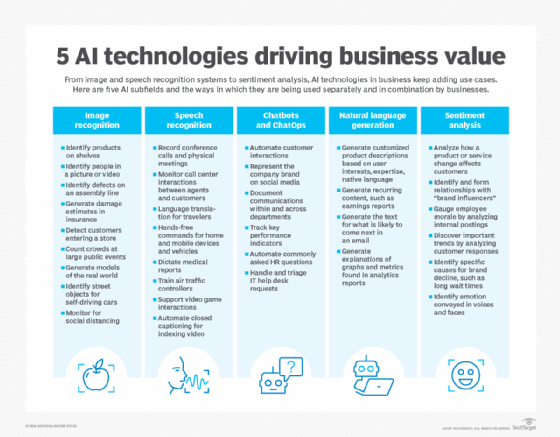
putilov_denis - stock.adobe.com
Reality check: Analysts check in on the AI hype cycle
AI applications still come with significant hype, but with a targeted approach, organizations can get the most out of their applications.
As a mainstay enterprise tool, AI is deployed with high expectations for ROI. But a more realistic approach is needed to move its technologies along the hype cycle.
AI technologies like machine learning, chatbots and deep learning are being adopted in numerous organizations, but the results have not been quite as advertised. Though use cases continue to grow, widespread acceptance and integration of AI remains elusive.
A realistic understanding of the individual technologies that make up AI as well as a targeted approach are keys to maturing the field beyond its initial hype.
So where are we with AI?
When analysts evaluate the maturity of AI, the first step is to parse out the many technologies that fall under the AI umbrella. Natural language processing, RPA, machine learning and deep learning have all found individual use cases across industries within the past few years.
"2020 is the year that AI is going to enter the mainstream of enterprise adoption," said Jack Fritz, a principal in Deloitte Consulting LLP's Technology, Media, and Telecommunications practice. "It's already integrated into a lot of enterprise applications like ERP, CRM."
In a survey of 1,100 AI adopters, Deloitte found that about 70% are using machine learning and around half of them were deploying deep learning. These fundamental applications of AI power self-driving vehicles, speech recognition as well as fraud detection and supercomputing.
Fritz says that we're seeing the mainstream of enterprise adoption right now. Fritz sees that organizations remain bullish on AI and those who have applied the technologies under the AI umbrella have seen good returns but there has yet to be a full widespread adoption across industries.
AI remains at the peak of the hype cycle, but a lack of full-scale adoption points to a problem with adoption and a general hesitation across enterprises to adopt even mildly advanced tools and technologies.

Applications vs. expectations
Along Gartner's Hype Cycle for Artificial Intelligence for 2020, artificial intelligence technologies have just climbed the inflated expectations mountain or have begun to move down to the trough of disillusionment. Organizations have seen these technologies' capabilities in the enterprise, and their expectations have started to become more realistic.
This shift in perspective on AI has done some work to limit the adoption of artificial intelligence. Gartner analyst Whit Andrews has seen some individual adoption, but not to the extent that had been predicted in his organization's surveys.
"What our data implies from the CIO survey is that organizations' ambitions are substantially greater than their capacity to execute on them," Andrews said.
Twenty percent of the CIOs surveyed in Gartner's CIO survey say they will be using AI in their organization, but only about 5% complete the transition and follow through to deployment. The desire remains and the expectations are high, but the transition has proven to be difficult for enterprises.
These current applications are not the widespread adoption of AI once thought of as inevitable. In 2016, Andrews' advice for artificial intelligence was to just get started with it. This meant broad investment in numerous areas in order to understand where it would best fit. In 2017, when AI was a less mature field, AI adoption was poised to take over in the coming year.
But as machine learning, chatbots and other AI technologies have become more common in the enterprise, organizations have gained a better understanding of what to expect, and the investment isn't as transformative as portrayed. This realization works against the overwhelming hype of years past but has yet to push all of AI to a more mature place, a place where there is a full understanding across industries of where the technologies work and what the expectations should be going into application.
Moving AI along the cycle
Artificial intelligence has advanced in the last few years but so long as the expectations on ROI exceed reality, it will struggle to move along towards effective technological enlightenment.
"A substantial proportion of organizations now employ artificial intelligence," Andrews said. "The challenge increasingly is how you employ it in a commonplace manner, as part of your overall technology strategy and technology direction."
To counter this hype and position an organization towards effectively implementing AI, AI requires buy-in from C-level management. Ensuring that these positions understand and approve of the AI projects is a large step in ensuring that AI adoption goes well.
"You want to have a C-level visibility and C-level accountability," Andrews said. "You want the organization to fund your AI strategy at that C-level."
Tying in the line of business parts of your organization ensures that there are no surprises and the organization is broadly comfortable with any changes. And, though it may seem counterintuitive to the future of broad integration of artificial intelligence, the recommendation from Andrews is to target your AI deployments at proven success use cases at the moment.
"The resource cost of every proof of concept, of every formalized employment of AI, is going to be substantial," Andrews said. "So be careful, pick and choose, don't entice your C-level executive into a losing proposition."








